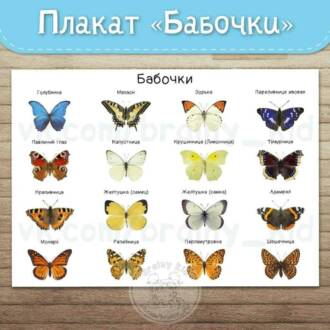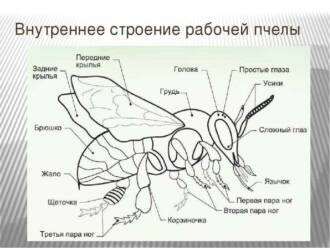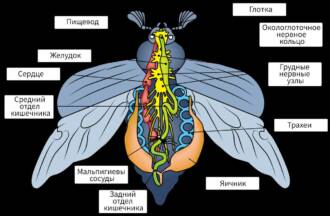The scientific name of the death's head butterfly is Acherontia atropos. It is a day butterfly of the hawk moth family (the largest hawk moth in Europe). It got its name for the yellow skull and crossbones pattern on its dark brown back. The body length is about 6 cm, and the wingspan is up to 13 cm. The butterfly is considered the heaviest on earth - its weight reaches 9 grams.

Hawk hawk caterpillar up to 15 cm long, has a curved horn. There are various colors: yellow-blue, green, brown.
The dead head usually feeds on nightshade plants (potato, nightshade, belladonna, dope, tobacco), and sometimes others: jasmine, raspberry, lilac.
Butterfly Dead Head can be found in apiaries, where she sucks honey, over warm valleys and low mountains. It is interesting in that, when irritated, it makes a piercing squeaking sound. The frightening coloration and strange sounds that the moth makes have given rise to incredible rumors.
The dead head is a butterfly with a wingspan of up to 13 cm, which belongs to the order hawks. Another name for the butterfly is also known - Adam's head. This insect is the largest in Russia. In Europe, it is the second largest in size - the championship in terms of body size in pear saturnia. The death's head hawk moth is easily recognizable due to its characteristic coloring - on the insect's body there is a bizarre pattern that vaguely resembles a human skull. For this feature, the butterfly got its Russian name. Most European nations gave her similar names. The creepy appearance has made this insect a popular character in books and horror films.

Description of the species
The dead head moth was first described in the scientific literature in Systema naturæ by Carl Linnaeus. In his work, the insect is referred to as "Sphinx atropos". In 1809, the German entomologist Jacob Heinrich Laspeyres transferred the hawk hawk of this species to the genus Acherontia (this is a reference to the Acheron River, located in the kingdom of Hades), to which the butterfly is still classified today.
The front wings can be from 40 to 50 mm, but cases have also been recorded when their size reached 70 mm. Wing size varies between males and females. For the former, it is from 90 to 115 mm, for the latter, from 100 to 130 mm. Front wings with a smooth outer edge. They are much longer than wide - the difference can be 2 times or more. The hind wings have slightly different proportions compared to the front wings - they are 1.5 times longer, a strong bevel towards the rear edge is noticeable.

The weight of individuals can be from 2 to 8 g, while females are heavier than males. The color of the head of the insect is most often black. On the butterfly's chest, you can see a frightening yellow pattern that looks like a human skull. However, this feature is absent in some species, for example, in Acherontia atropos f. obsoleta.
The coloration of males and females is different. In males, most of the abdomen is colored ocher-yellow, gray-blue or black is also found in color. In females, only the last segment has this coloration. hawk hawk this kind It has abdomen of impressive size, covered with scales, the length of which can be up to 60 mm with a diameter of up to 22 mm. At the end there is no tassel of scales. The abdomen varies in shape - in the male it is slightly pointed, and in females it is rounded.
The eyes of the insect are round. The proboscis is not long - from 10 to 14.5 mm. The palps are well developed, slightly curled upwards. Outside they are covered with scales. Short antennae slightly curved before apex. The legs are strong and short.
The dead head usually rests during the day, picking out tree trunks and stumps to remain invisible to others, and stays awake at night. Butterflies can be found at night in the light of lanterns and lamps.

In case of danger, insects first try to frighten the enemy - they flap their wings loudly, make unusual sounds, and then try to hide as soon as possible, choosing secluded places for this. When disturbed, butterflies prefer to hide in crevices in the bark or under leaves. In case of danger, males can release a special substance from the glands to scare off opponents, the smell of which vaguely resembles the smell of mushrooms.
There are three types of butterflies, the name of each of which is associated with ancient myths:
- Atropos - that was the name of the Greek goddess of fate, who cut the threads of lives;
- Styx - the river of the dead;
- Lachesis is the goddess of fate who measures the length of life.
Butterfly singing
One of the features of a butterfly of this species is the ability to make unusual sounds. This skill is endowed not only with a butterfly. Both the chrysalis and the caterpillar can "sing", while at different stages of development the voice of the insect varies significantly.
Scientists have been interested in this feature since ancient times. So back in the 18th century, the Dutchman Jan Swammerdam tried to understand how a butterfly makes sounds, but could not find the answer. In the 19th century, research was carried out by the Frenchman Réaumur, but he was not lucky either. The riddle was solved only in 1920. It's all about special building pharynx of an insect - while drawing in air, its pharynx works like bellows. A thin film in the goiter begins to vibrate, an unusual sound appears.
In 2006 and 2007, tourists vacationing in Mexico, where there were many butterflies of this species, were amazed by the collective song of insects.

Habitat of Acherontia atropos
The dead head insect can be found in Africa, Saudi Arabia, Iraq, Iran and other countries. It is common in the subtropical and tropical zones. In addition, the butterfly is found in Central and Southern Europe. In Crimea, seeing a dead head is a real success, because it is practically not common there. On the territory of Russia, this species was seen only in some areas - for example, in the Moscow, Kaluga and Krasnodar Territories. Also, a butterfly can be found in Armenia, Azerbaijan and Abkhazia.
Moth hawks annually fly to the north, where they form temporary colonies. The distances that butterflies cover vary depending on weather conditions. In some years, the insects even reach Iceland.

In the middle of the 19th century in England there were so many hawks of this species that farmers decided to use insects to feed poultry.
In Africa, where conditions are most suitable for hawk moths, the butterfly can be seen all year round. Butterflies move very quickly, their speed can be up to 50 km per hour. They prefer to settle in sunny areas located in the lowlands, overgrown with grass and shrubs. You can see a dead head in deciduous forests, but in the highlands they are rare guests and are listed in the Red Book.
Peculiarities
The hawk moth is distinguished by a thick proboscis, because of which the insect cannot eat the nectar of flowers. Therefore, one has to be content with tree and fruit juice. Many species of hawk moths are compared with hummingbirds because of their peculiarity - the insect seems to hang over the bud when it drinks nectar, quickly flipping its wings. However, the dead head butterfly does not have such a feature - acherontia atropos prefers to sit down before having a bite.

One of the insect's favorite treats is honey. The death butterfly may enter the hive or try to fool the bees and then pierce the comb and snack. The portion that she eats at a time is from 5 to 15 g. There is a theory that the sounds made by a cunning insect are very reminiscent of bees. This belief is widely spread among beekeepers, who watch butterflies with interest, but scientific evidence for a curious fact has not yet been found.
The black hawk hawk is believed to release certain chemicals to mask its scent. If the attack in the hive could not be avoided, a dead head can withstand up to five bee stings. Beekeepers do not sound the alarm - the butterfly does not interfere with beekeeping because of the small number. For prevention, special nets are installed around the hives, through which bees easily penetrate, but butterflies cannot, because the diameter of the cells is about 8 mm.

If danger suddenly arises, the insect emits a sharp and piercing squeak. The caterpillar also makes sounds as a result of rubbing its jaws. It is amazing that the chrysalis does not remain silent. It has not yet been possible to find out how and for what purpose it makes sounds, but most scientists agree that this is done to intimidate enemies.
The appearance of offspring
The second generation of female deadheads are sterile, so the population can only grow with a new wave of migrating butterflies. Each year, two offspring of an insect are born. In warm years, sometimes three generations are hatched, and in cold years, not all caterpillars have time to pupate. In this case, insects die due to adverse conditions.
First, females attract the attention of males with the help of pheromones, then the insects mate. Females lay up to 150 eggs at a time under the leaves of fodder plants. The egg of this insect is oval, it is blue or light green. A moth with a skull does not appear immediately - at first, gardeners see large caterpillars that have five pairs of legs. Their length is about 12 mm. By the fifth age, this indicator changes significantly - caterpillars reach up to 15 cm, their weight can be from 18 to 22 g.
The color of the caterpillars is different. There are yellow-blue, brown and green individuals. The most common are lemon yellow, on the body of which you can see blue stripes converging on the back at an acute angle. For eight weeks, while the insect is in the caterpillar stage, it spends most of it underground (usually at a depth of up to 40 cm). Usually, the larva partially protrudes from the shelter to reach the nearest greenery, snack on tobacco, eggplant or tomato, and then hide underground again.

The pupa of the male is from 50 to 65 mm, the female - from 65 to 75 mm. The maximum pupa size is 80 mm. Weight can be from 7 to 12 g. The color after pupation is initially yellow or cream, after 12 hours it changes to red-brown.
Butterfly Dead Head and its lifespan
The caterpillar usually lives up to two months, after which pupation occurs at a depth of 15 to 40 cm underground. The pupae can hardly tolerate the cold, and therefore die en masse if the weather conditions are unsuitable. A month later, an adult is born from the pupa, the life expectancy of which is also no more than a month.
Dead Head Enemies
The butterfly has many enemies in nature. At any stage of the life cycle, it can suffer from parasitoids - those who survive with the help of the host. Some insects are able to lay their eggs directly on the caterpillar. Caterpillars sometimes eat tachin eggs along with the leaves. In this case, the parasites develop inside - they eat the internal organs, and then leave the body of the insect.

Butterfly with a skull on its back in culture
Unusual and frightening coloring has led to the emergence of numerous superstitions. In different countries, the dead head moth is a harbinger of serious troubles, its appearance was even associated with epidemics.
It is enough to drive into the search “moth dead head photo” or “dead head photo” to understand why this type of butterfly has been catching up and continues to terrify superstitious people. In the photo, a creepy insect with a catchy color has become popular with writers and screenwriters, to see it or You can read about him in the following films and books:
- - The Silence of the Lambs (directed by Jonathan Demmy);
- - the film "Casket of Damnation" (director - Ul Bornedal);
- - the story "Sphinx" (author - Edgar Allan Poe);
- - the story "Dead Head" (author - Alexander Belyaev);
- - the novel "I am the king of the castle" (author - Susan Hill).
In Russia, it used to be that if you saw a butterfly with a skull on its wings, you must certainly kill it in order to avoid misfortunes and losses. There are also other interesting facts and myths:
The superstitious inhabitants of England believed that the dead head butterfly was friends with sorcerers and witches and whispered to them the names of people who were soon to die. Some African tribes are still convinced that the bite of this butterfly can be fatal. In European countries, it is considered a bad sign if a butterfly accidentally flies into the house - this can portend serious illnesses, losses and other troubles to the owners.
The author of The Antiquary wrote a strange story - the inhabitants of Lincolnshire convinced the writer that the caterpillar of an unusual butterfly could easily transform into a mole. In some countries, it is believed that if a scale of hawkweed dead head accidentally gets into the eye, then you can even lose your eyesight.
Butterfly Guard
The Red Book contains information about this butterfly. Usually there are single individuals, but the population size does not remain unchanged every year, it is influenced by weather conditions. The warmer the year is, the more butterflies. In cold years, on the contrary, there are significantly fewer insects of this species.
The number is judged by the pupae found. In the USSR, the dead head hawk hawk suffered from chemicals that were used to treat fields to combat various pests. In connection with the invasion of the Colorado potato beetle, large areas had to be used for growing potatoes with insecticides. The probability of survival of the offspring of the dead head butterfly of the first wave after such control measures is minimal.
Read more:





